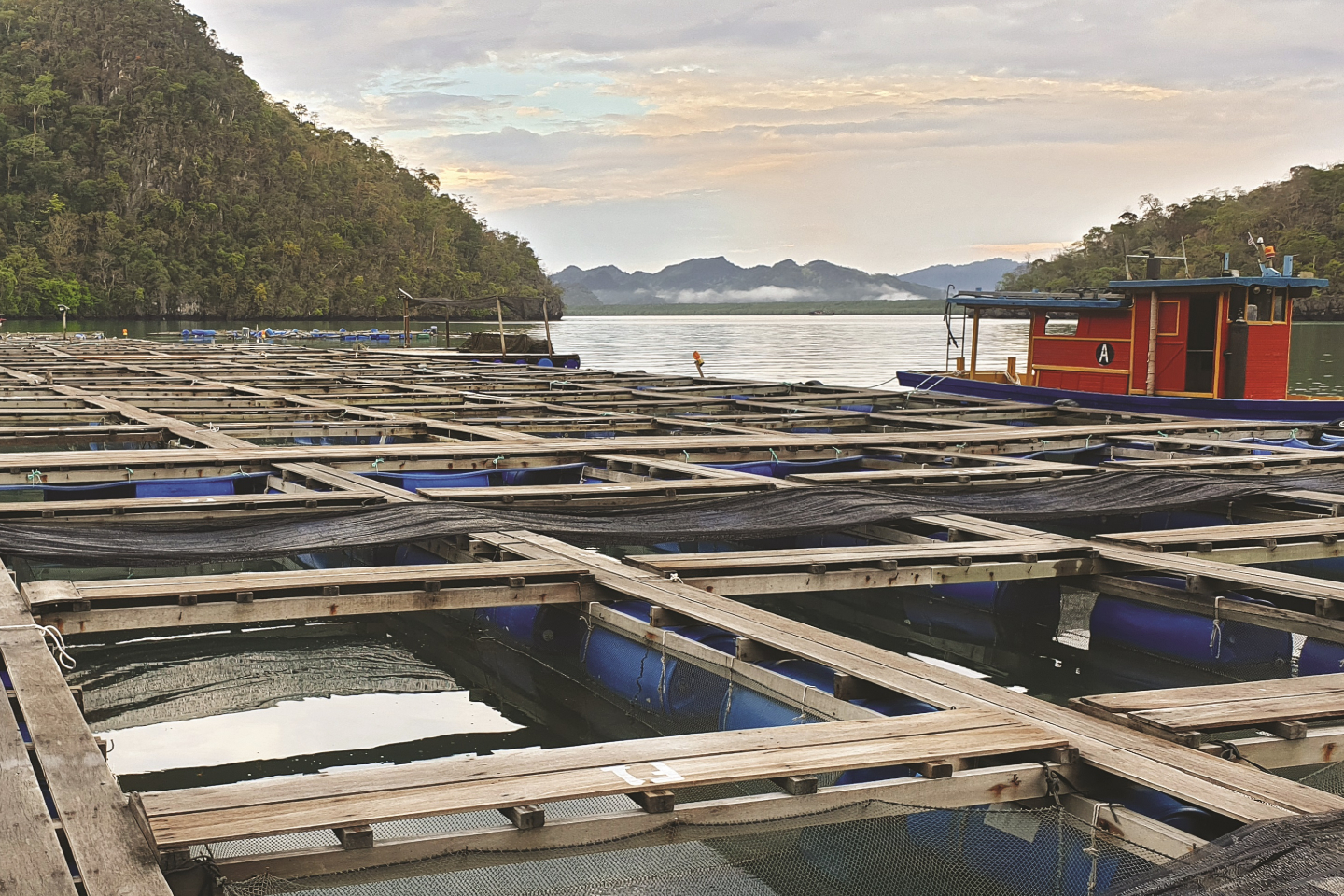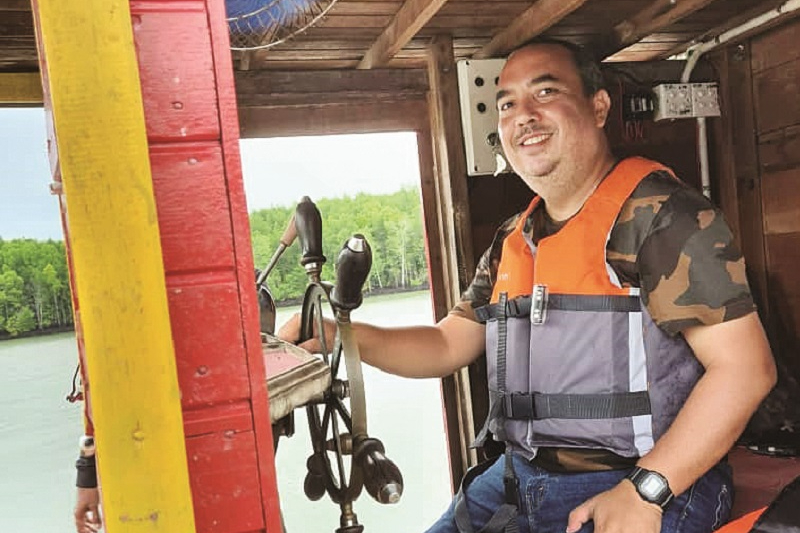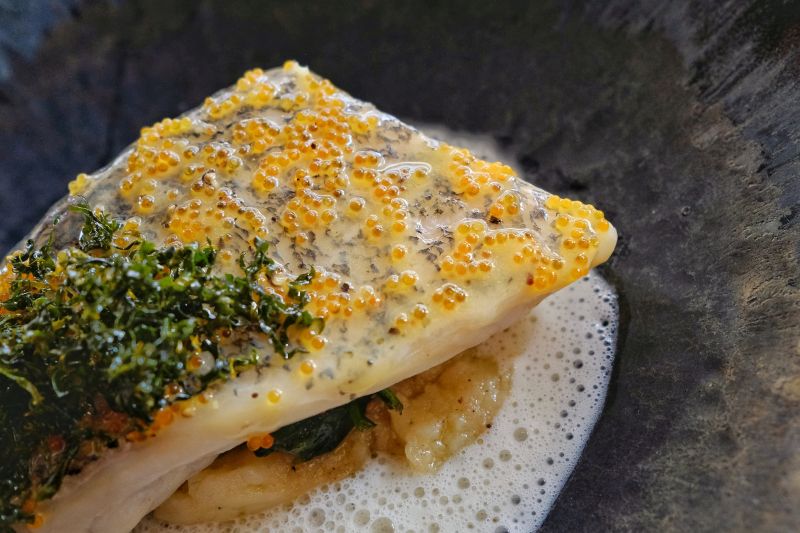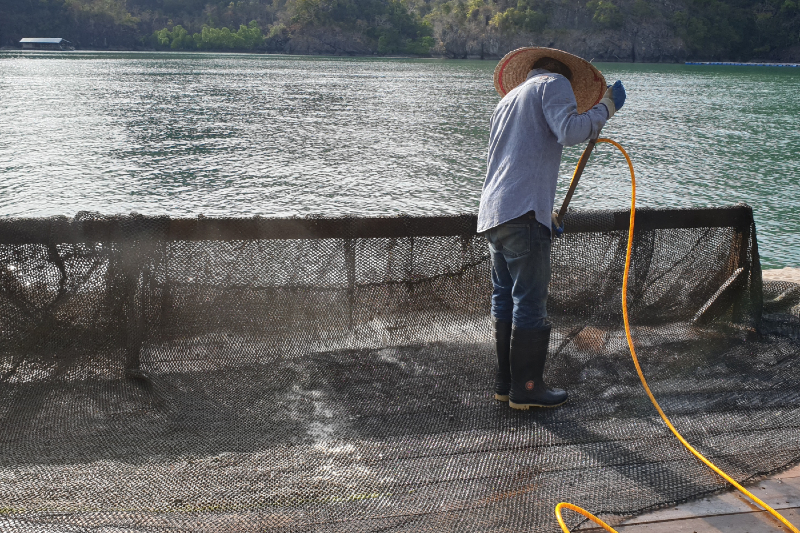
Lang Biru Fisheries has 150 floating cages at the northeast tip of Langkawi (Photo: Lang Biru Fisheries)
Before he met his wife Rebecca Pek in 2003, Adam Badri ate only two types of fish — ikan bilis and fish and chips. As she enjoys seafood, he began to like it too. Over the last year, access to catch from his own farm or those brought in by boats to the jetties has given him a new appreciation for fish. Having fresh kembong and sardines, which he did not like previously, is now a “totally different experience”.
The sea change led him to drop anchor in Langkawi where, together with partners Eric Dass Anthony and Tajudin Shariff, he set up Lang Biru Fisheries in August last year. The grow-out facility houses 150 floating cages, measuring 3m x 6m each, in waters 15m to 18m deep in Selat Anak Tikus, among the islands off the northeast tip of the Langkawi archipelago.
“We wanted a location that was relatively remote, with relatively deep water and away from the general population. When you get to the deeper waters, you get much better circulation and more controlled temperature gradients. The fairly remote location also means the farmers are always helpful to each other. If you need help, somebody is always willing to offer advice or assistance. It’s an ideal community.”
The farm breeds dragon tiger groupers and red snappers, released into the cages in batches. A third species, jenahak, will be included and should be in the market next year. Lang Biru gets its name from helang (Malay for eagle, found in abundance on the island) and biru (for marine blue).
adam_badri_1.jpg

The seafood aquaculture operation is a new venture for Adam, 43, who did his master’s degree and PhD in materials science and engineering at Carnegie Mellon University in Pennsylvania, and worked for Royal Dutch Shell in Malaysia, Boston Consulting Group and Sapura Energy before joining Sapura Secured Technologies, which he still consults for.
“To tell you frankly, I never sold anything until I sold my first fish. If you had asked me two or three years ago about my ambition, I would have said CEO. I also received an association award [the AIME Champion H Mathewson Award] in 2008, so the journey to fish could have not been less obvious.
“Now, I really want to be a fish farmer, but somebody who operates on a very large scale,” adds the Lang Biru managing director.
The partners are strong in managing people, sales and stakeholder engagement, he adds. They have another company, Bukit Api Farms, set up at the same time last year to do lowland farming of everyday vegetables, which they supply directly to shops in Pahang.
Marketing the harvest from Lang Biru is a different kettle of fish, given the global environment today. When it started, restaurants bought its harvests in bulk. Foreign demand was high too — boats would pull up to load fish by the tonne, for export to Hong Kong and China. But fresh Hong Kong pro-democracy protests that started end-2019 and carried over into 2020 followed by the Covid-19 outbreak proved to be a damp squib and “that market literally evaporated”, says Adam. They were left with “several tonnes of fish that need a home on a plate”.
“We have to figure out how to not just survive but come out of this stronger.” Strategies include cash preservation — keeping costs low and farm facilities fit for purpose — and being prudent. For instance, instead of fancy accommodation, he stays in a rented kampung house when he visits Langkawi every fortnight.
Expansion is key but even that requires discipline. There is also the need for consolidation. The company has acquired a facility in Sabah to breed fingerlings. It currently buys two-month-old fingerlings (about 25g each and the length of a finger) from breeders and releases them into the cages, where they grow for another nine months until they are about 1kg to 1.2kg. Groupers, known as Sabah fish, are especially popular at banquets and harvests will serve the market there.
With Covid-19 putting the brakes on eating out again, the team has had to explore non-traditional areas of demand, like getting their fish onto the degustation menu of a French restaurant, as happened at Bistro à Table in Petaling Jaya recently.
bistro_a_table_garoupa.jpg

Approaching different buyers is challenging but interesting, says Adam. There are sales, albeit on a smaller scale. They have also begun to sell to individuals via home delivery, as have many farmers in the same situation.With research showing that people are more accepting of buying fish online, Lang Biru connects with consumers via social media and a network of online grocers to which it supplies certain fish.
“A lot of people feel they cannot do justice to ‘restaurant fish’. It’s like wagyu; even I am nervous buying wagyu and would rather have a chef [cook] it,” But customers have been very satisfied with what they have been able to do with fish — steam, fry, cook curry or make fish and chips — and selling it filleted or in smaller sizes from next year will add to its appeal.
Why fish farming to begin with? Not to diminish anything that other farmers do, he says, Adam sees a looming protein crisis as well as a looming food crisis globally over the long-term sustainability of food supply. Following the feed conversion ratio, which measures how much an animal needs to eat to generate body mass, fish require the least amount of food. From a human consumption perspective, you get a lot more of what you put in from fish, significantly so than from other creatures.
Competition (the local chicken industry is well established) and space (cattle need grazing grounds and a concentrated area for feed locking) weigh against breeding these animals. Fish farmers can use the offshore areas that are not utilised for other purposes, Adam points out. At the same time, only a small portion of marine capture in Malaysia is actually high-grade fish, like groupers and red snappers. So, it is viable to farm them commercially.
20200205_172812_1.jpg

As an enterprise committed to caring for the environment, his farm supplements electrical generation with solar energy, provides engineered sanitary facilities, and waste-removal to shore. Management systems and procedures are designed to ensure safe and efficient operations, and they hire local staff as far as possible.
Humane fish treatment is a priority at the facility, says Adam. “For those who make a decision to eat fish or other animals, and especially as a farmer, you cannot run away from the fact that they are living things. You need to make sure they are taken care of. If not, your livestock will have disease, they will have stress and problems, and that translates into a higher mortality rate.”
From a morality aspect, farmers also have to deal with the fact that what they breed becomes food. “It’s not an original line from me but I heard one farmer say, ‘Take care of the livestock well and you will realise that maybe, at some point, they have one bad day’.”
For him, that realisation dawned when he was driving the first batch of live fish from Langkawi to Kuala Lumpur. “I thought, ‘I’ve been looking after these fish for eight or nine months and now, we’re giving them up for people to eat’. It gave me pause. But we make choices, and I think it’s how you manage that choice and how you do it as best as you can [that are important].”
For Lang Biru, good fish care means maintaining low stocking densities, a good feeding regime and high-quality feed. It uses deep nets so there is no crowding at the top. Cages are rotated and water quality is monitored. As the stocks grow, fish of different sizes and growth rates are segregated and placed in holding areas for further grow-out prior to sale.
“It makes good operational sense to do so,” says Adam, who believes “you do well by doing right”. He is hoping to break even in three years.
This article first appeared on Oct 19, 2020 in The Edge Malaysia.


